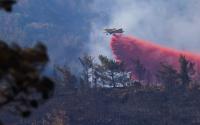5 September 2004Martha Dixon |
 The future of America's largest national forest is in the balance |
It is made up of a lush archipelago of 1,000 forested islands and fjords across the panhandle of south-east Alaska. It's called a rainforest because it rains here up to five metres a year.
Heavy logging has left clear-cut scars across this vast area, but the industry which was vital to this remote economy has slowed in recent years. Many loggers blame the Clinton administration's environmental controls.
Now the Bush administration is doing everything it can to get the American sawmills started again.
Protests
The Tongass was recently exempted from the hotly debated "roadless rule" brought in by Bill Clinton in the last few days of his presidency.
The rule sought to permanently block logging and other development from 58 million acres of national forest where no roads have been built.
The rule reversal has brought howls of protest from environmentalists across America - and from the Democratic presidential candidate John Kerry, who is promising to reinstate environmental protections for the Tongass if he wins in November.
In Alaska itself, native groups have joined up with environmental campaigners in an effort to reverse new large-scale logging plans.
People from the Haida native group have been travelling with the Greenpeace ship the "Arctic Sunrise" as part of their "endangered forests, endangered freedoms" campaign.
"The Tongass is the Amazon of North America - we're seeing unprecedented plans for logging here and the most significant dismantling of environmental protection laws in the history of the US," said Jeremy Paster, forest campaigner with Greenpeace.
 Many communities still live a subsistence life |
In Hydaburg, a remote village on Prince of Wales Island, local fisherman and artist Victor Tumulak showed me how the forest has changed. We walked through dense woods to a brown area which has been clear-cut.
"This is nice lush forest. This is what I grew up with. This is what I remember - now my kids have to grow up in this. This is devastation. It's killing off the fish - not only the fish but us - because we depend on the fish," said Victor.
The logging industry used to be a big employer in Alaska. Now much of it is reduced to a tourist attraction - with check shirts for sale in the souvenir shops across the region.
And there's a lot of anger at the environmental campaigners for attacking the industry.
"We are fighting for our survival as an industry - fighting misinformation and myths from environmental groups," says Owen Graham of the Alaska Forest Association.
"We are not targeting big trees in Alaska, our average log is about the diameter of a dinner plate."
 Much of the logging industry has been reduced to a tourist attraction |
"This forest reforests itself, with some of our most valued habitats regrown in prime condition. The forest plan is one of the best conservation strategies we've ever had - it's been developed to sustain a viable timber industry at a reduced rate of the past.
"The timber here is a huge resource that the communities in the Tongass are dependent on," says Forrest Cole, the Tongass forest supervisor.
Subsidies
Although Alaska does well from logging, it's a heavily subsidised industry. In 2003, sites in the Tongass received $36m of federal funds to cut them. The returns from selling timber were under $2m.
 Heavy logging has left scars across the landscape |
They say they can make a profit in the future. But they still don't know if they can count on more work.
It's taken four years since President Bush was elected to get the Tongass open to more logging. But now there's another election.
With John Kerry promising to bring back logging restrictions if he gets into office, the future of America's largest national forest is hanging in the balance.






